PWA: Bridging the Gap Between Web and Mobile Development
Progressive Web App(PWA) is fascinating. Let's learn about it and build a PWA using JavaScript and Vite
Not even Tim Berners-Lee, the inventor of the world wide web, could have predicted the pace or breadth of its expansion over the last 30 years.
Once, the web was only accessible via clunky desktop computers. Today it can be reached from laptops, tablets, mobile phones and even smartwatches. So today’s consumers want native apps that are unique to a particular platform, and they expect updates to arrive seamlessly.
Thankfully web browsers have evolved, too. The first generation of basic, homespun browsers (hello Mosaic, Midas and Netscape Navigator) have been replaced with feature-rich gateways equipped with modern APIs, which enable developers to achieve a native app experience without maintaining different codebases. And the Progressive Web App(PWA) is a crucial part of this evolution.
The Progressive Web App
A Progressive Web App is an application built with modern browser APIs on the web platform to provide a native (platform-specific) user experience from the same codebase. They bridge the gap between two distinct development approaches:
A native platform-specific mobile app (like Android and iOS apps). These are easy to install and update, provide access to native hardware and can be smoothly integrated with the app store. But they require us to maintain platform-specific codebases, which means different development environments and maintenance skills.
Web applications (which run on browsers). These do not need different codebases to maintain; we can distribute them easily over the web. However, the experience is not as rich as a native app.
Progressive web apps provide a third way. App developers can use the modern browser APIs to build applications from the same codebase, with the experience of native apps. You can install them, automatically update them, integrate them with the app store, make them work offline and more.
When we consider PWAs from the end user’s perspective, we will find them at the intersection of web and mobile applications.
Ok, now let’s look at the various aspects of building a Progressive Web Application and create one ourselves using Plain JavaScript and Vite.
Service Workers
There are a few fundamental pillars of PWA you should be aware of. Service workers are one such pillar, helping with caching, offline availability and fast loading.
Service workers are JavaScript source code that runs in a dedicated thread, separated from the main thread. They act like a proxy server between a client and a server; in the case of a PWA, the client is the browser, and the server is the data source (a dedicated physical server or cloud).
Service workers specialize in intercepting network requests and performing appropriate actions, like serving the data to the client from the cache storage (using the CacheStorage API) when offline, or from the server when online. They also aid the transmission of push notifications and background syncing.
Before you apply the service workers to your PWA, you must register them within your PWA. After successful registration, the service worker gets downloaded on the client to start the installation and activation process.
To register a service worker, you must check that the browser supports the service worker API, and register it. The code snippet below registers a service worker that is written in the serviceworker.js file.
if ('serviceWorker' in navigator) {
navigator.serviceWorker.register("/serviceworker.js");
}
You can also use your browser’s dev tools to establish whether a service worker has successfully activated after registration. The image below shows that a service worker is successfully registered, activated, and running.
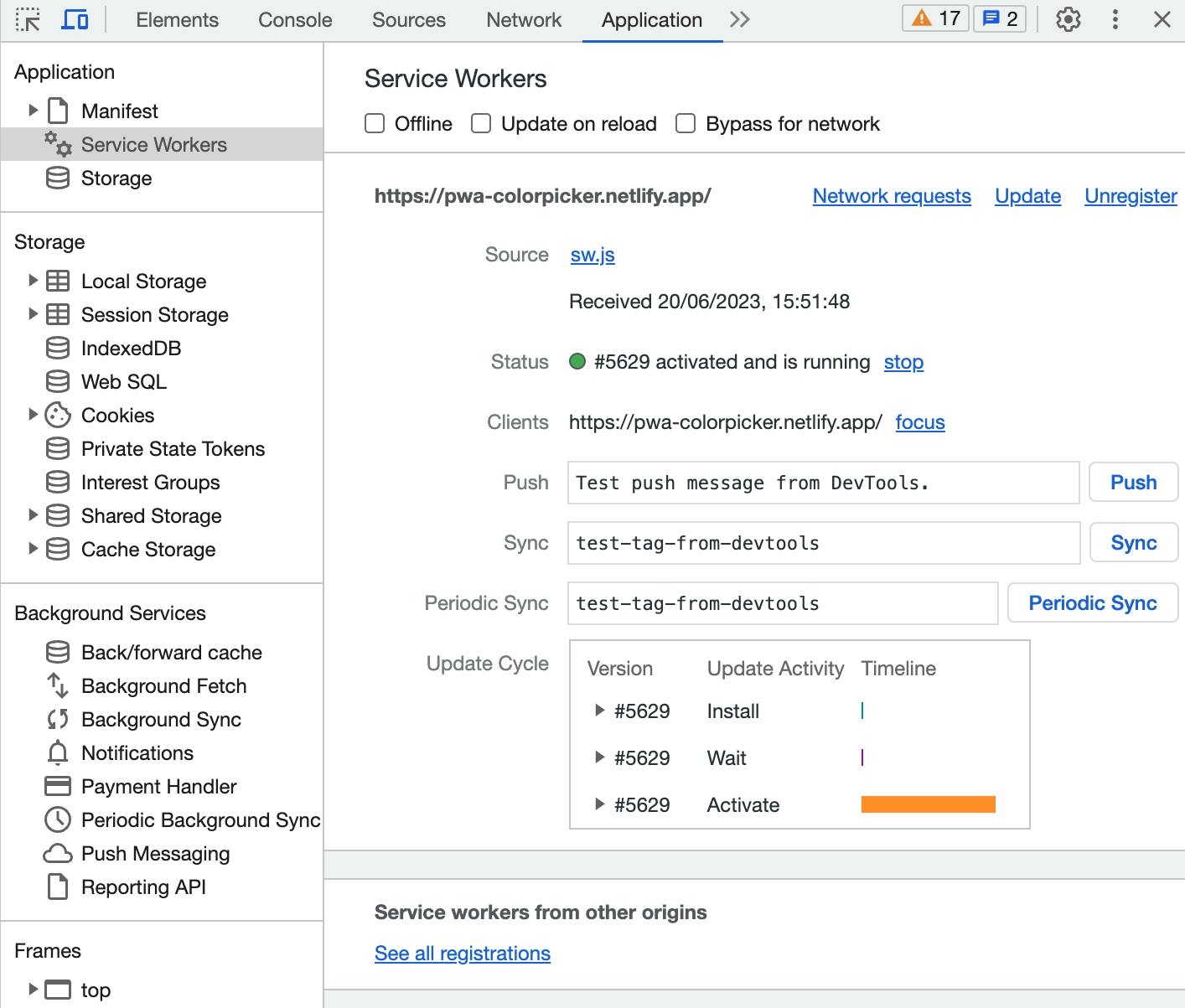
Also, please note that you can have only one service worker per progressive web app (PWA). The service worker only works over HTTPS, not HTTP, to ensure security and encryption.
App Manifest File
Your PWA also needs meta-information about the application, such as the name, description, icons, and launch mode (standalone or full-screen).
You need to provide this information in the app manifest file, a JSON file called manifest.json. Here is an example of how the content of the app manifest file may appear:
{
"name": "Color Picker",
"short_name": "ColorPicker",
"start_url": "/",
"display": "standalone",
"background_color": "#fdfdfd",
"theme_color": "#ffffff",
"orientation": "portrait-primary",
"icons": [
{
"src": "/images/icons/icon-72x72.png",
"type": "image/png", "sizes": "72x72"
},
{
"src": "/images/icons/icon-96x96.png",
"type": "image/png", "sizes": "96x96"
},
{
"src": "/images/icons/icon-128x128.png",
"type": "image/png","sizes": "128x128"
},
{
"src": "/images/icons/icon-144x144.png",
"type": "image/png", "sizes": "144x144"
},
{
"src": "/images/icons/icon-152x152.png",
"type": "image/png", "sizes": "152x152"
},
{
"src": "/images/icons/icon-192x192.png",
"type": "image/png", "sizes": "192x192"
},
{
"src": "/images/icons/icon-384x384.png",
"type": "image/png", "sizes": "384x384"
},
{
"src": "/images/icons/icon-512x512.png",
"type": "image/png", "sizes": "512x512"
}
]
}
All the details you provide in the manifest.json file will be used in the mobile app installation process; the app icon, app name and app mode will all be taken from the file. You can see the details in the manifest file loaded into your app from the browser’s DevTools.
The image below shows how the manifest information is loaded into the app from the manifest file example we saw above.
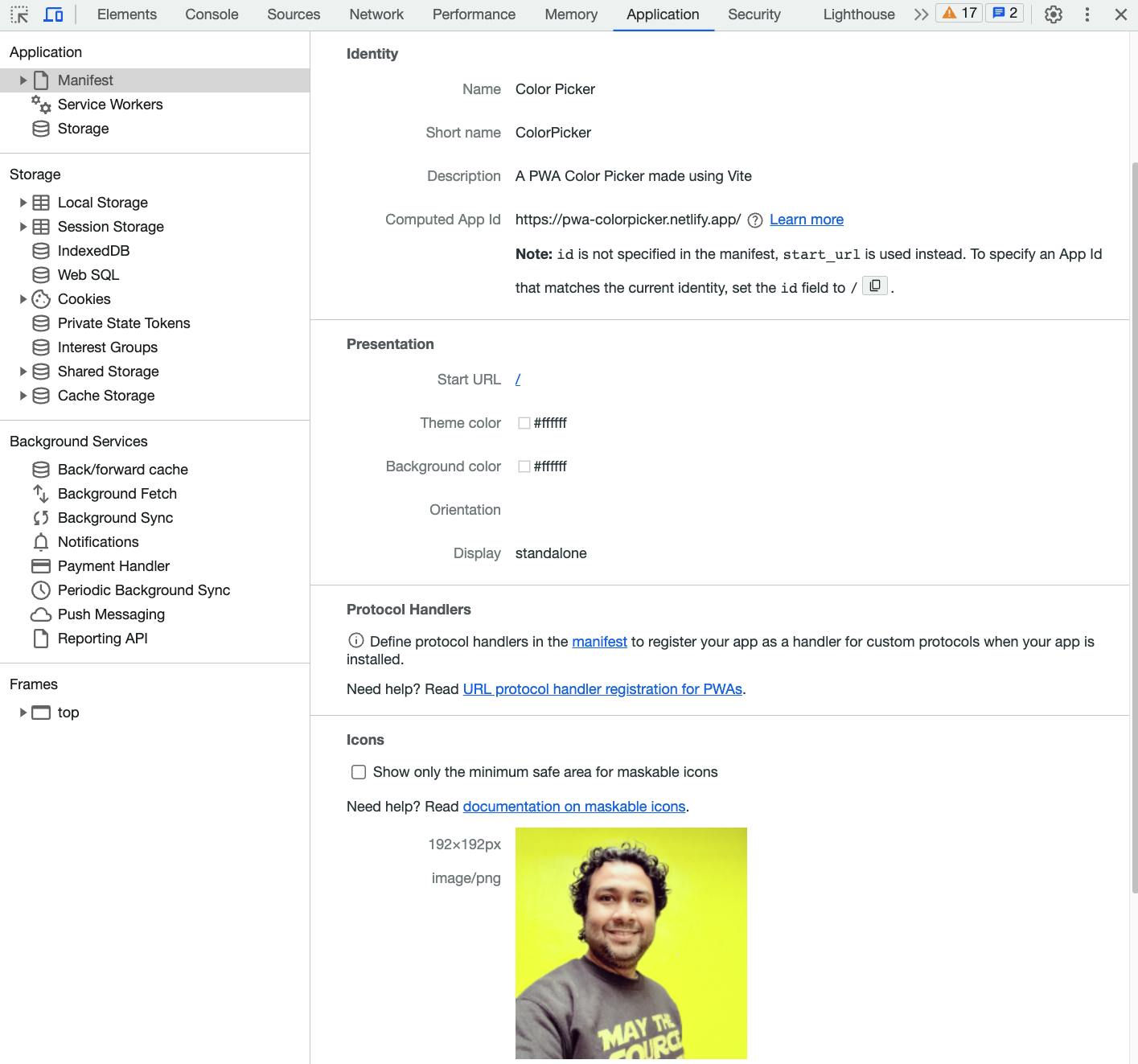
Caching
Progressive Web Apps are known for offering speed and high availability on users’ mobile devices. So much so, in fact, that they can work completely or partially in offline mode. Caching helps achieve that, which makes the gap between a PWA and a native mobile app smaller.
The service worker uses Cache Storage API to interact with the cache and manage assets as appropriate. As a developer of the PWA, you must decide what you want to cache and what your caching strategy should be.
For example, you may want to cache the following assets:
All the static images
CSS Styles
All static fonts
Static data that comes from a JSON file
The entry-point index.html page or any other pages
JavaScript files that serve the business logic
You must also consider the space on the user’s mobile device before considering what you want to cache.
You can explore and adapt various caching strategies, based on the application’s use cases. Here are the five most popular strategies to explore:
Cache only
Network only
Stale-While-Revalidate
Cache first, then Network
The network first, then Cache
Some of them are self-explanatory, but a few need explanations outside this article's scope. You can read more about caching here.
Let’s Build a Progressive Web App using JavaScript and Vite
We now have enough foundations to build a Progressive Web App and understand things practically. So let’s build a simple Colour Picker the app, where users can see a bunch of color palettes and select a color code by clicking on it.
We will use plain JavaScript, HTML, and CSS to build this application (this can also be done using other libraries or frameworks like React or Angular). We will also use a front-end tooling system called Vite, which has a plug-in to support PWA.
If you get stuck at any point, the application source code is available here for you to follow, along with the article:
GitHub – atapas/colorpicker-pwa: A project to demonstrate PWA strategies
Setting things up
First, open a command prompt or terminal and execute the following command to create a vanilla (plain) JavaScript project using Vite.
yarn create vite colorpicker-pwa --template vanilla
This will create all the necessary files and folders for you to get started with the JavaScript application.

Next, we will install the Vite PWA plugin. The plugin vite-plugin-pwa abstracts away lots of low-level complexities from the developer and helps define necessary things declaratively.
yarn add vite-plugin-pwa
Getting the assets ready
We need to create a few assets to build a logo, icon, and favicon for our app. I use favicon.io to create these assets; you can upload a picture, creating many assets for you. Please extract them and copy them under the public folder of your project.
Now, create the robots.txt file under the public folder with the following text:
User-agent: *
Disallow:
At this stage, the content of the public folder may look like this:
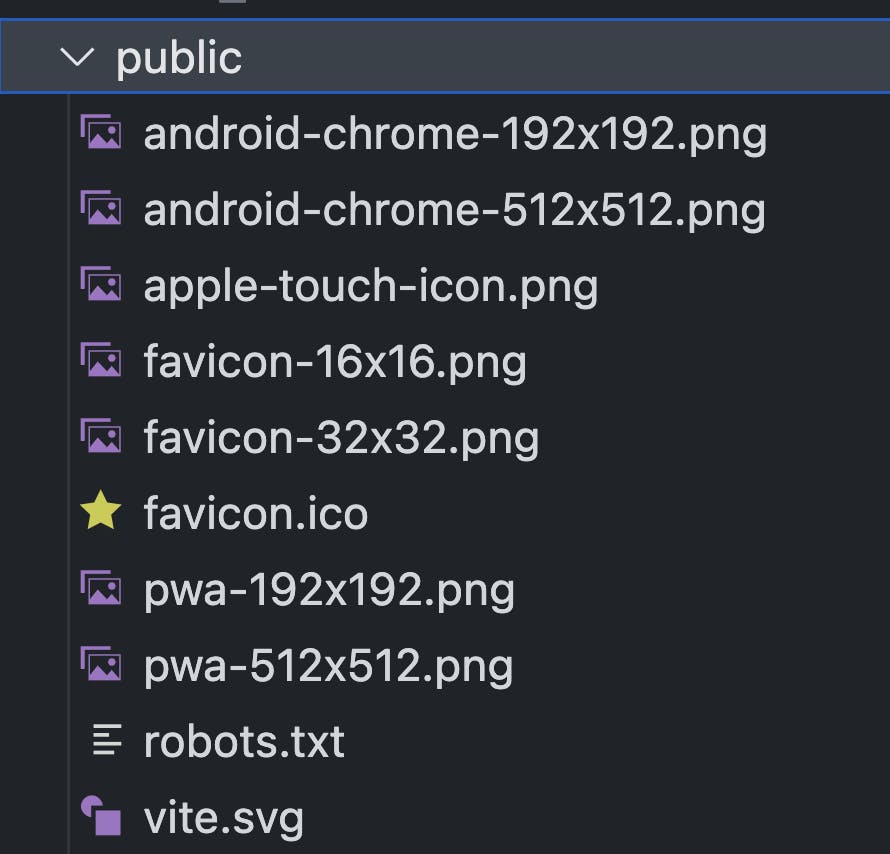
Next, open the index.html file and add these assets as meta tags. Use the following code to replace the content of the index.html file.
<!DOCTYPE html>
<html lang="en">
<head>
<meta charset="UTF-8" />
<!-- Fields you will add start -->
<meta name="viewport" content="width=device-width, initial-scale=1.0" />
<title>Color Picker</title>
<meta name="description" content="A PWA Color Picker made using Vite">
<meta charset="UTF-8" />
<link rel="manifest" href="/manifest.webmanifest">
<link rel="icon" href="/favicon.ico" />
<link rel="apple-touch-icon" sizes="180x180" href="/apple-touch-icon.png">
<link rel="icon" type="image/png" sizes="32x32" href="/favicon-32x32.png">
<link rel="icon" type="image/png" sizes="16x16" href="/favicon-16x16.png">
<link rel="mask-icon" href="/masked-icon.png" color="#FFFFFF">
<meta name="theme-color" content="#ffffff">
<script type="module" src="/main.js" defer></script>
</head>
<body>
<div>
<header>
<h1>
Color Picker - PWA
</h1>
</header>
<div id="app"></div>
</div>
</body>
</html>
Build the application logic
Now, let’s build the application logic.
First, we will create the data that represents the color palette. To do this, create a data folder at the root of the project folder and create the file color-data.js under it, with the following content.
export const colors = [
{
"data": "#de3516"
},
{
"data": "#ef9baf"
},
{
"data": "#5903b2"
},
{
"data": "#6a8217"
},
{
"data": "#a40115"
},
{
"data": "#fbf9ad"
},
// add more colors of your choice
]
We will use this data in the main.js file and build our logic to create the colour palette. To do this, open the main.js file and replace the content with the following:
import './style.css'
import {colors} from './data/color-data'
const createColorPallet = () => {
colors.forEach((color) => {
const colorPallet = document.createElement('div')
colorPallet.classList.add('color-pallet')
colorPallet.style.backgroundColor = color.data
const colorName = document.createElement('div')
colorName.classList.add('color-name')
colorName.textContent = color.data
colorPallet.appendChild(colorName)
colorPallet.addEventListener('click', () => {
const colorCode = color.data
console.log(colorCode)
copyContent(colorCode)
})
document.querySelector('#app').appendChild(colorPallet)
})
}
const copyContent = async (text) => {
try {
await navigator.clipboard.writeText(text);
console.log('Content copied to clipboard');
alert(`The color ${text} has been copied successfully`);
} catch (err) {
console.error('Failed to copy: ', err);
}
}
createColorPallet()
Let’s go over the code:
We first import the colour data, which is an array.
Then we iterate over the array and create the required DOM elements to create the pallet.
Next, we add a click handler on each colour DIV to copy the colour code into the clipboard.
Lastly, let’s add some styles to make things look better. Open the style.css file and replace the content with the following code.
body {
margin: 0;
}
#app {
max-width: 1280px;
margin: 0 auto;
padding: 2rem;
text-align: center;
display: flex;
flex-direction: row;
flex-wrap: wrap;
align-content: center;
justify-content: center;
align-items: center;
}
.color-pallet {
width: 200px;
height: 200px;
margin: 5px;
border-radius: 5px;
display: flex;
justify-content: center;
align-items: center;
cursor: pointer;
}
.color-name {
color: #ffffff;
}
That’s it! Now if you run the app locally (using the yarn dev command) or by deploying somewhere on the cloud (like Netlify or Vercel), it will look and behave like this:
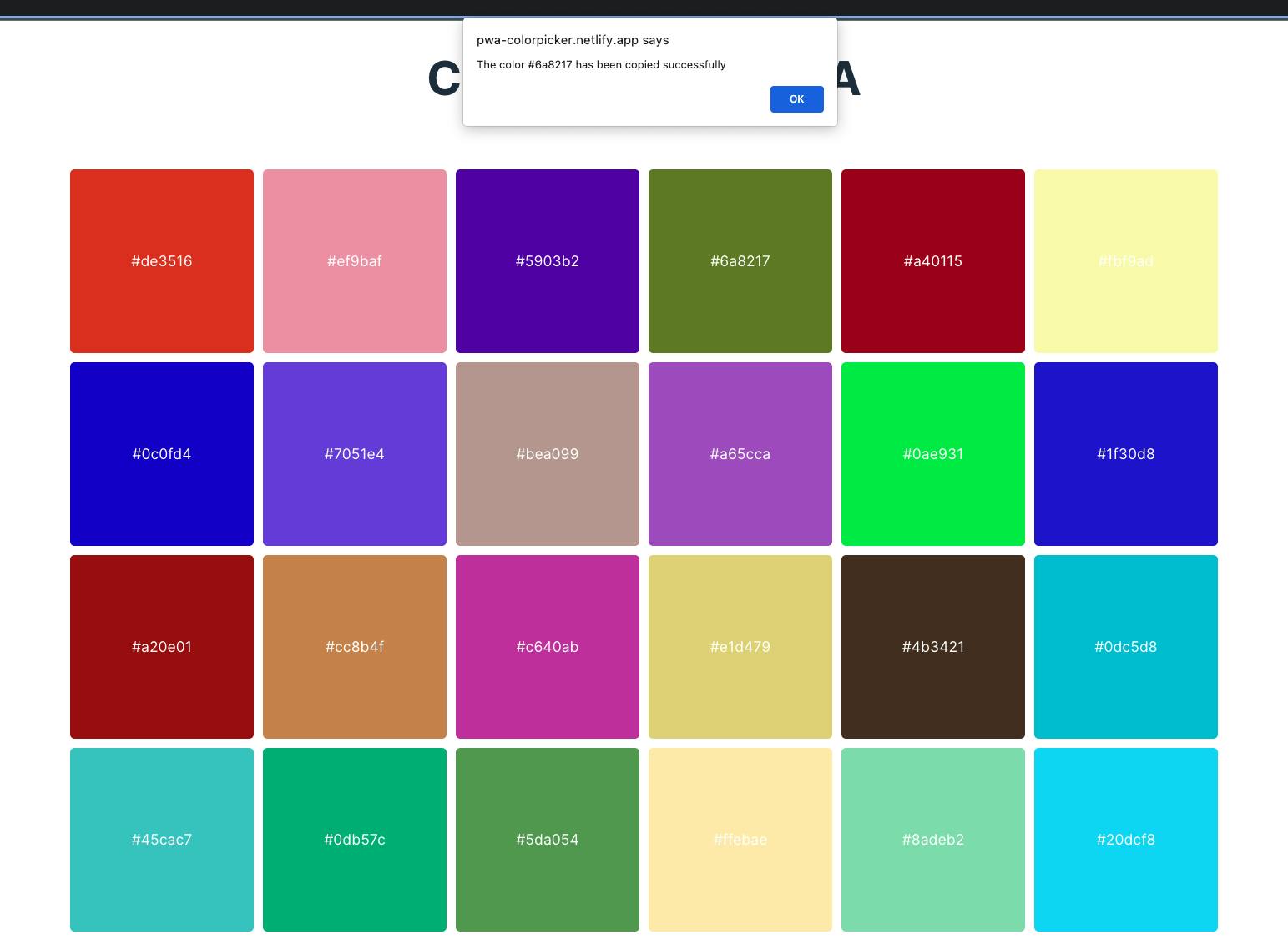
Now, Let’s Configure PWA
The app is ready now, and it’s time to configure and turn it into Progressive Web App to provide a better user experience to our customers.
The PWA Vite plug-in allows you to configure things declaratively. To take advantage of this feature, create a file vite.config.js at the root of the project folder, with this content:
import { defineConfig } from 'vite';
import { VitePWA } from 'vite-plugin-pwa';
export default defineConfig({
plugins: [
VitePWA({
registerType: 'prompt',
includeAssets: ['favicon.ico', 'apple-touch-icon.png'],
manifest: {
name: 'Color Picker',
short_name: 'ColorPicker',
description: 'A PWA Color Picker made using Vite',
theme_color: '#ffffff',
start_url: '/',
"display": "standalone",
icons: [
{
src: 'pwa-192x192.png',
sizes: '192x192',
type: 'image/png',
},
{
src: 'pwa-512x512.png',
sizes: '512x512',
type: 'image/png',
},
{
src: 'pwa-512x512.png',
sizes: '512x512',
type: 'image/png',
purpose: 'any maskable',
},
],
},
}),
],
});
As you see, we have defined the application metadata in the configuration file and passed it to the VitePWA plugin. If you are not using the plugin, you must create a manifest.json file with all the metadata information at the root of the project folder.
Register the Service Worker
The last thing we need to do is to register the service worker so that it starts caching the assets we need offline. Open the main.js file and import the registerSW function.
import { registerSW } from 'virtual:pwa-register'
Next, add the following code to register the service worker.
if ("serviceWorker" in navigator) {
const updateSW = registerSW({
onNeedRefresh() {
const isUpdate = window.confirm('New Update Available. Click OK to update');
if (isUpdate) {
updateSW(true);
}
}
});
}
Here we are doing something more than just registering.
We first check whether the browser supports the service worker API.
Then we invoke the
registerSW()function to register the service worker.We pass a configuration object to the register method to define a callback so that we can prompt the user if the PWA is updated later.
Now, build the app using the yarn build command and preview it using the yarn preview command. You can also deploy and host the app publicly on Netlify/Vercel. Simply launch the app on your browser, and open the DevTools.
Here we used Google Chrome. Under the Application tab of DevTools, we can navigate to the Storage option to see all the cached assets.

Now, click the Service Workers option and select the offline mode to check the app works from the cached data.
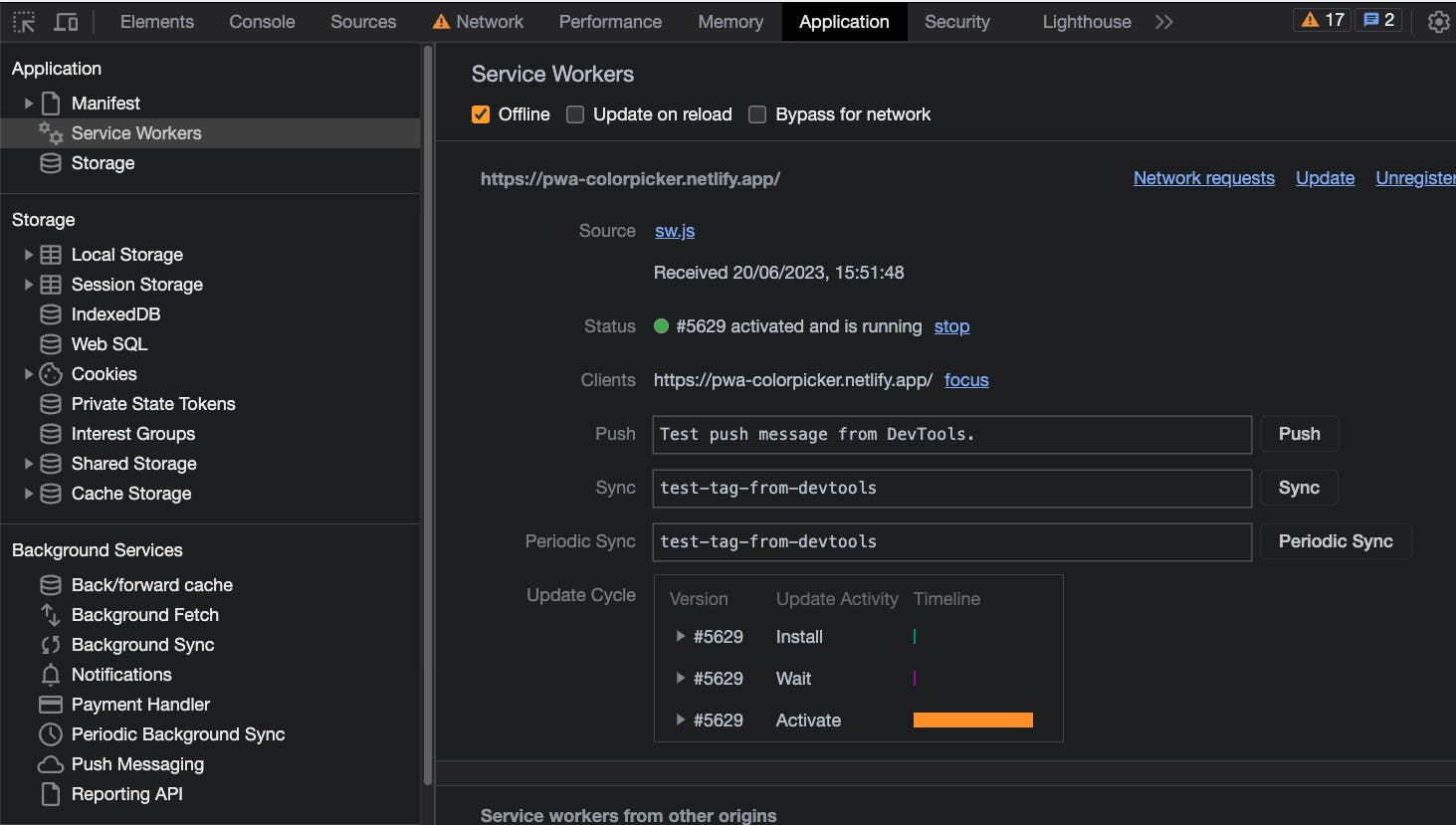
You can now install the app locally on your device and add it to the home screen to access it easily! Once installed, the app will be updated automatically, and you can launch it anytime.

Validate PWA with Browser’s DevTools like Lighthouse
Now open the lighthouse tool from the Chrome DevTools and run the assessment. Once the assessment is over, it will show a stamp if the application is PWA-enabled.

You can click on the PWA icon to drill down into various audits of your app and take action accordingly.

And That’s it!
I hope you found this article insightful and got some useful information about PWAs and how to build them.
All the source code used in this article is in my GitHub repository.
Don’t forget to give a ⭐ if you have liked the work. Also, this project is open-source, so feel free to tweak it, and enhance it to adapt other caching strategies.
This article was Originally Published on Bugfender.
Bugfenderis a log storage service for application developers. It collects everything happening in the application, even if it doesn’t crash, in order to reproduce and resolve bugs more effectively and provide better customer support. Get started with Bugfender from here.
Before We End...
Thanks for reading it. I hope it was insightful. If you liked the article, please post likes and share it in your circles.
Let's connect. I share web development, content creation, Open Source, and career tips on these platforms.

